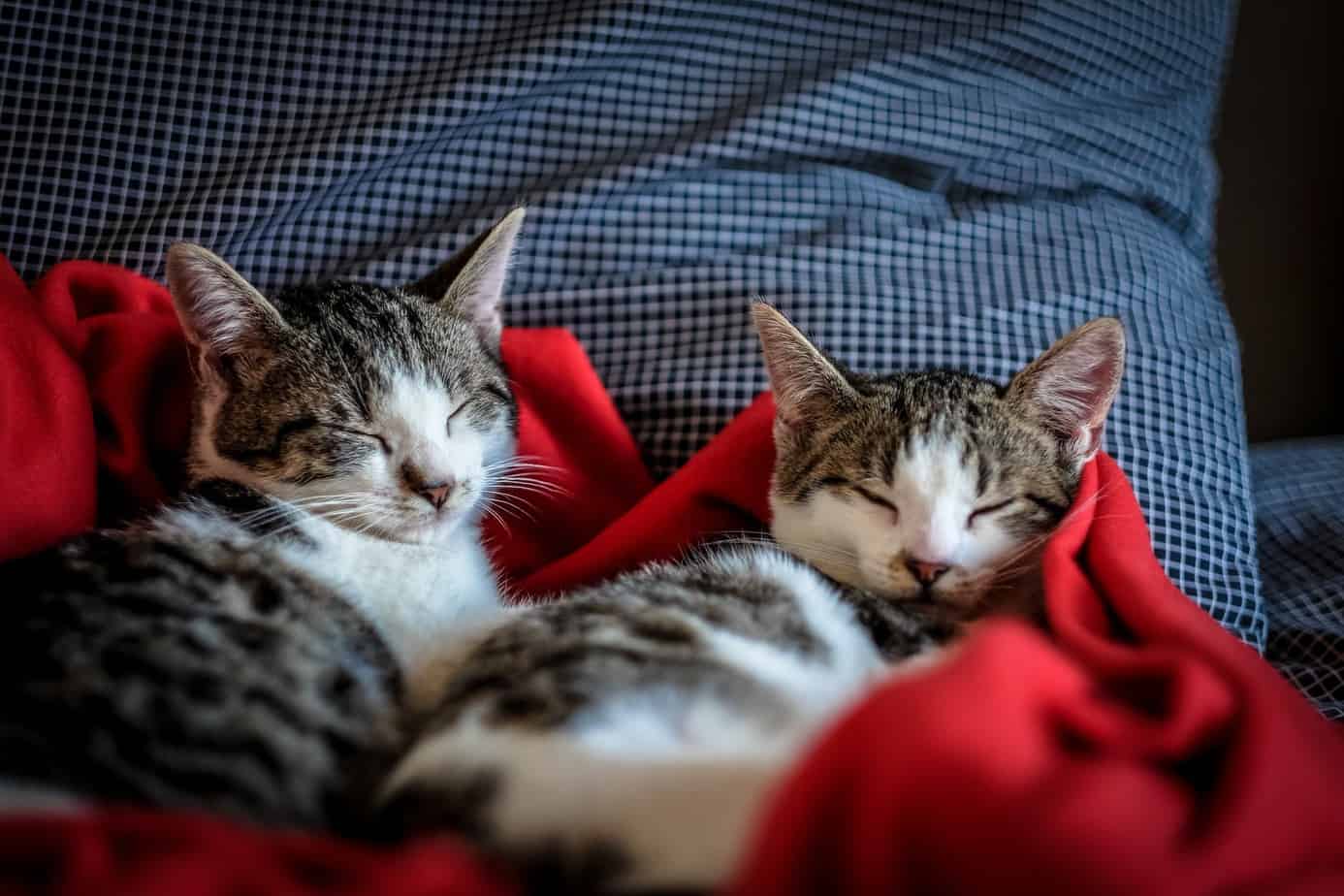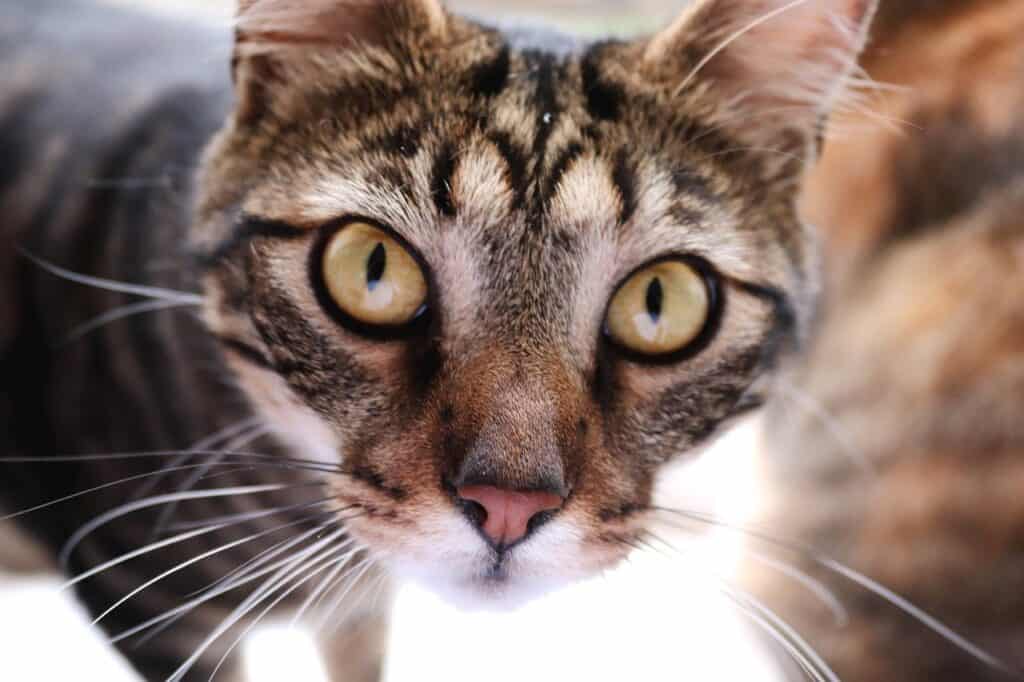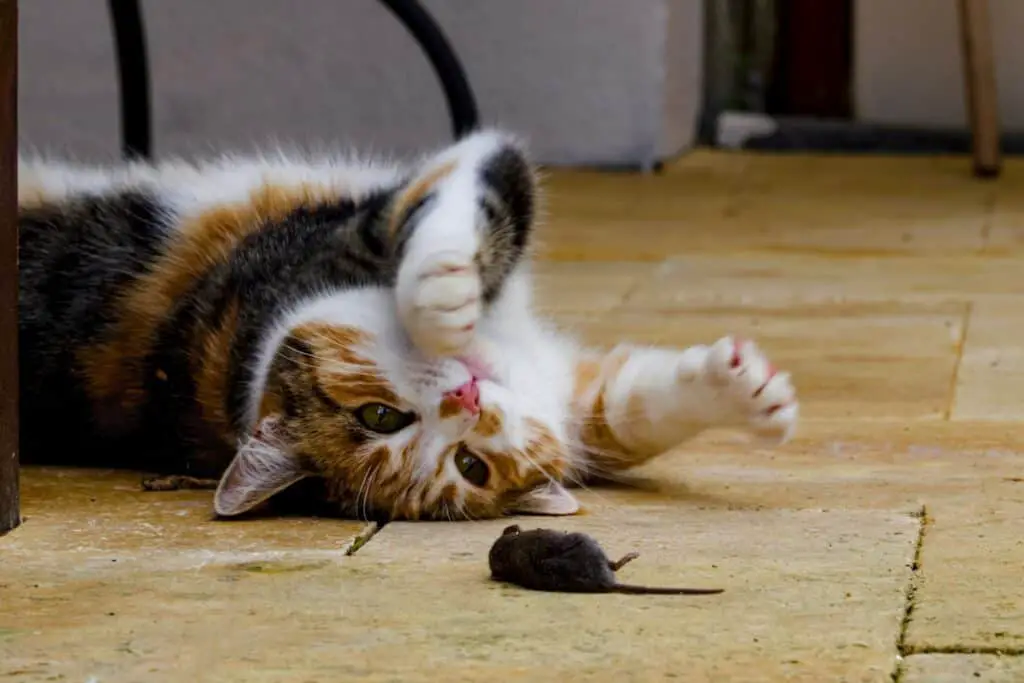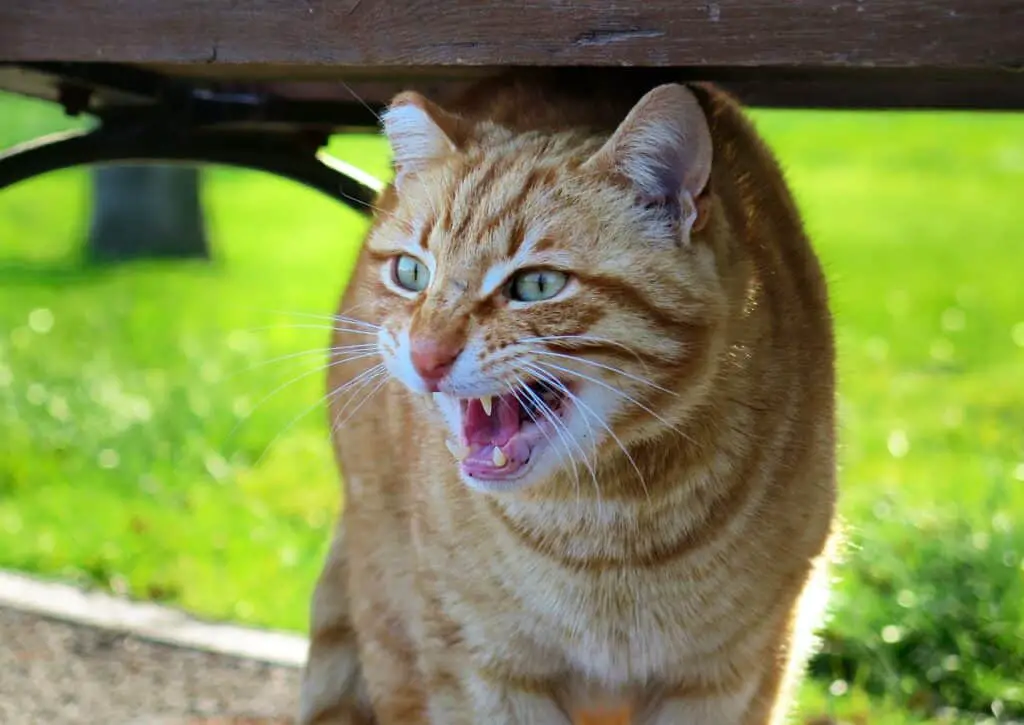Cat sleeping positions can reveal a lot about their personality, health, and how they are feeling. Although every cat is different, all cats sleep a lot and their sleeping positions seem to be universal among cats.
Wonder why your furry friend sleeps in that awkward position? Here we’ll go over all the common sleeping positions of your cat and break down the science behind why cats sleep in a certain way.
13 common cat sleeping positions explained
1. Curled up crescent
The curled up, or crescent, this position is among our cats’ most common sleeping position.
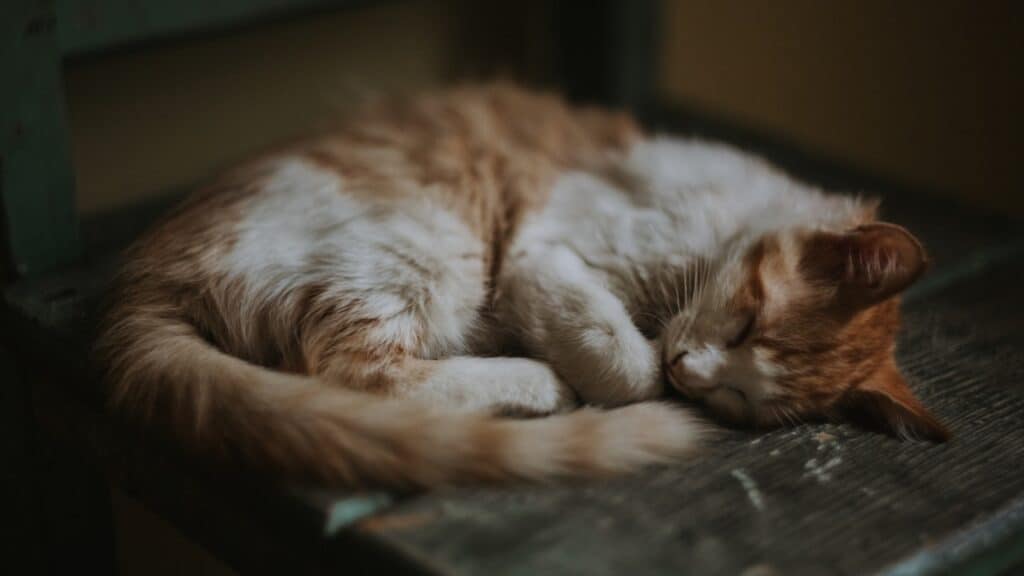
Not only have cats adopted the curled-up position as their favorite many animals in the wild sleep like this, and for good reasons.
The cat curls up its body and tail and tucks its head towards its chest in this position. This sleeping position has many benefits. It helps preserve body heat and protect their vital organs while they sleep.
2. Tucked into a box
It’s no secret that cats like to sleep in boxes, drawers, under the couch, or in other tiny spaces.
Cats love hiding out in tiny spaces, and it’s an instinct that’s very useful when hunting. Cats curl up and hide in the wild, ready to pounce when their prey is within range.
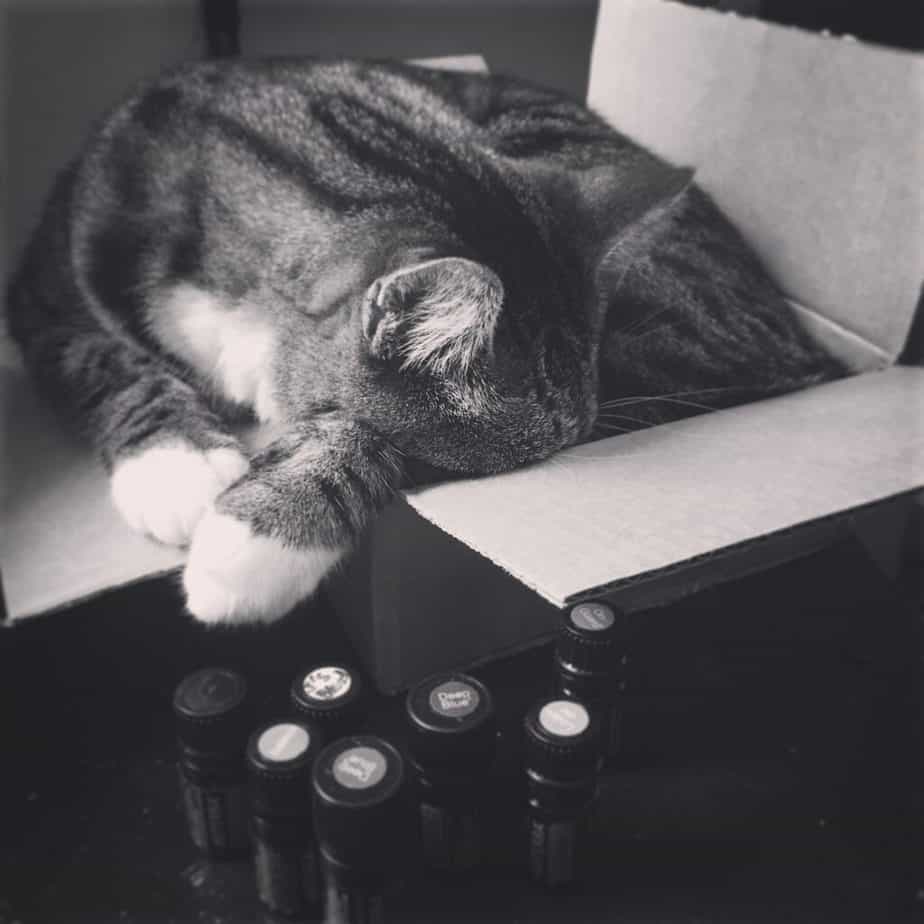
Hiding in a box or small space makes cats feel safe.
They can hide from other predators while keeping an eye on what’s happening. So, it’s usually perfectly normal if your cat likes to sleep in tight spaces or be hidden from sight.
If your cat does this all the time and also hides away during its waking hours, something might be wrong, and your kitty might not feel safe.
In that case, try to find out what’s causing this. Maybe little kids are rampaging around the house, robbing your cat of a quiet place to sleep?
Always try to provide your cat with a safe place to sleep. Cats need a lot of sleep, and sleep deprivation may cause stress or other physical and mental health problems.
3. Belly up
When you find your cat sleeping in the belly-up position, you’re in luck. This is a sign that your cat feels completely comfortable and safe in your home and with you. It is a clear sign of trust towards their owners.
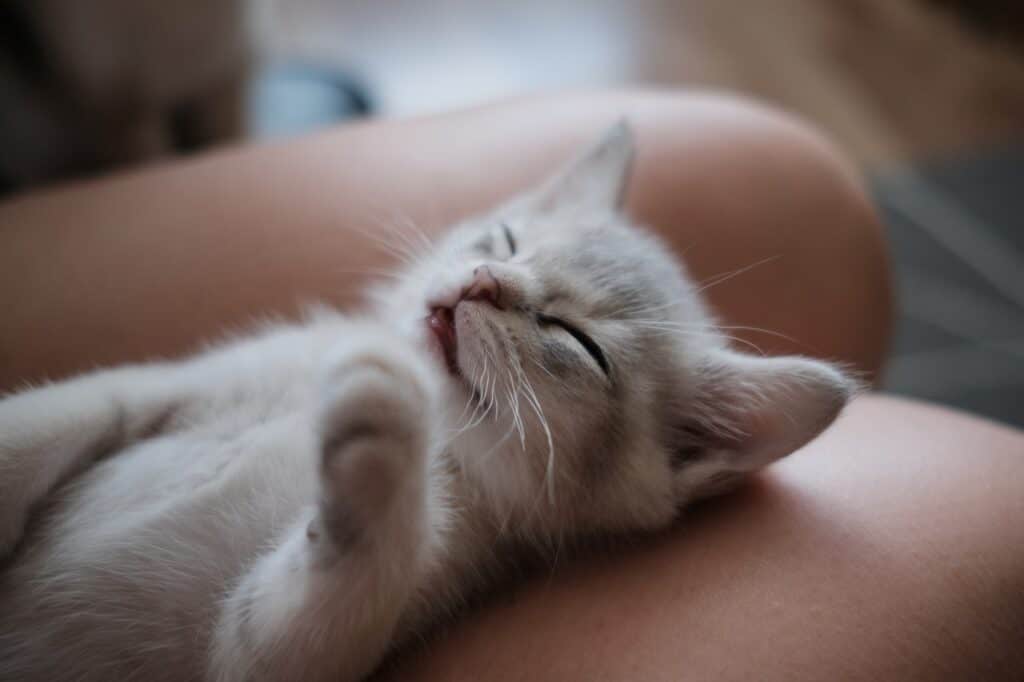
Cats only expose their bellies, which contain their most vital and delicate organs, when they feel at ease, and there is no reason for caution. Or, of course, when they are in need of belly rubs.
4. Eyes half open
Even though our domesticated cats usually live in safe homes where other predators do not constantly threaten them, their instincts to always be alert are strong.
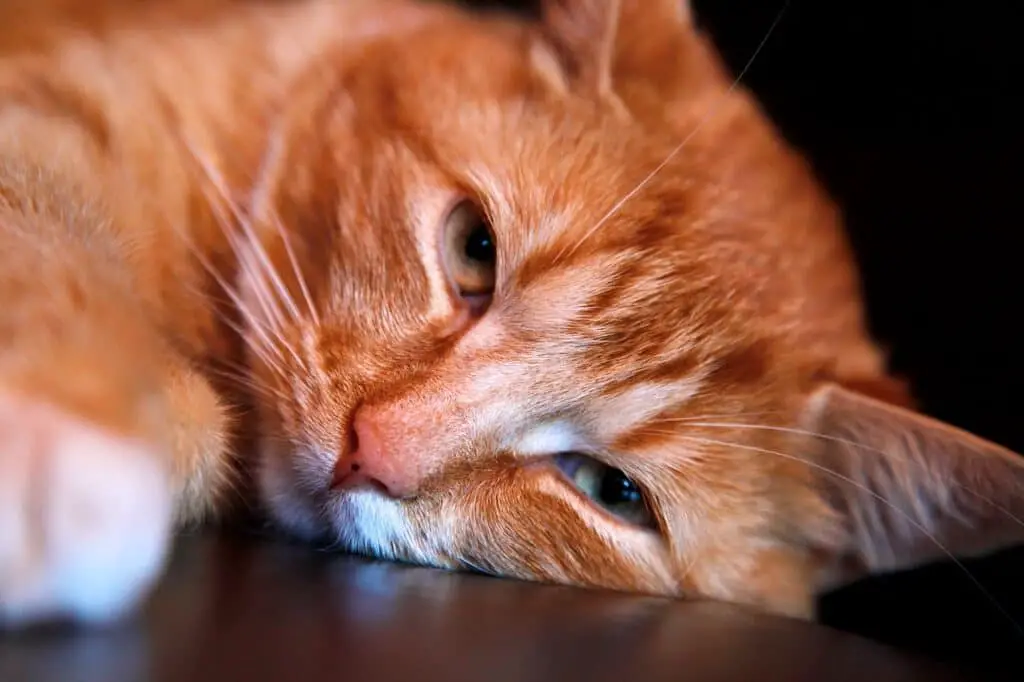
Cats possess the unique ability to be asleep and alert at the same time. You might see your cat sleep like this when they’re not at ease, when people move around a lot, or when kids are playing nearby.
In this state, your cat will sleep with eyes slightly opened or one eye closed and one eye open. You might also see their ears moving while asleep, listening for any danger sign.
Although it’s a very light form of sleep, and your cat will wake at the faintest of sounds, they are not entirely awake and are in a state between sleep and consciousness.
5. Cat loaf
Cat loaf sleeping position: Your cat sits on all four paws with its front feet tucked underneath its chest.
This is a very typical cat resting position. Usually, cats sitting in the loaf position are just resting and not sleeping, or they might be practicing their half-asleep-half-awake state, as mentioned above. You can often see their ears moving while their eyes are closed, listening to every sound around them.
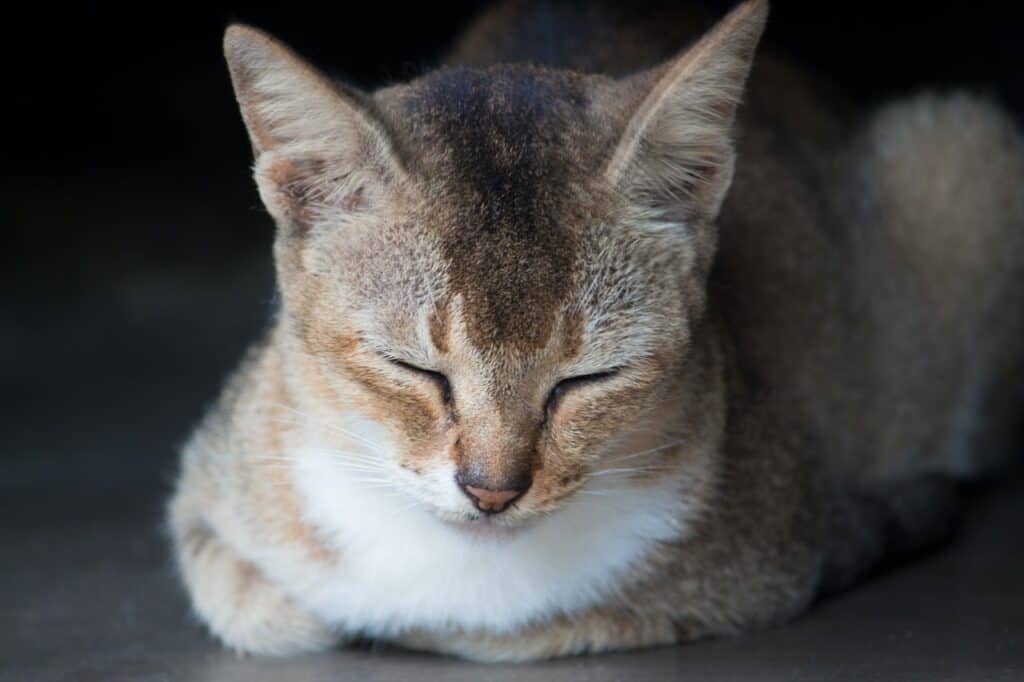
They can sit in this position for hours, but sometimes you might see your cat in the loaf position with their head down. This happens when they fall asleep while in this position.
6. Side sleeper
Cats sleeping on their side with their paws stretched out signifies that they are completely comfortable with their surroundings and often deep sleep.
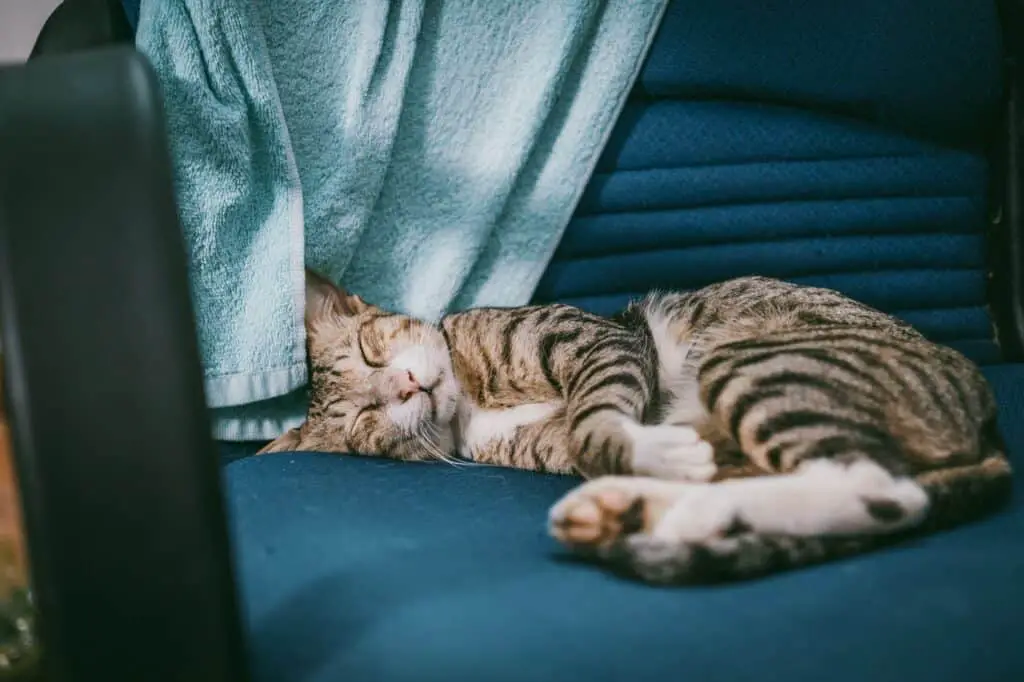
It’s best not to wake your cat when sleeping like this since they hate being woken for no reason when asleep.
It is clear when cats are comfortable in this position, but sometimes, cats might be coping with discomfort when sleeping or lying on their side.
Cats are masters at hiding their pain, and lying or sleeping on their side might signify belly aches, joint pain, or bruised ribs. If this is the case, you might see their ears pointed backward, and they will not want you to touch them.
Be sure to check with your vet if there is a reason for concern, as internal injuries can be hazardous for cats.
7. Paw over the face
Cats sleeping with one paw over their face or covering their eyes can be one of the most adorable things to see.
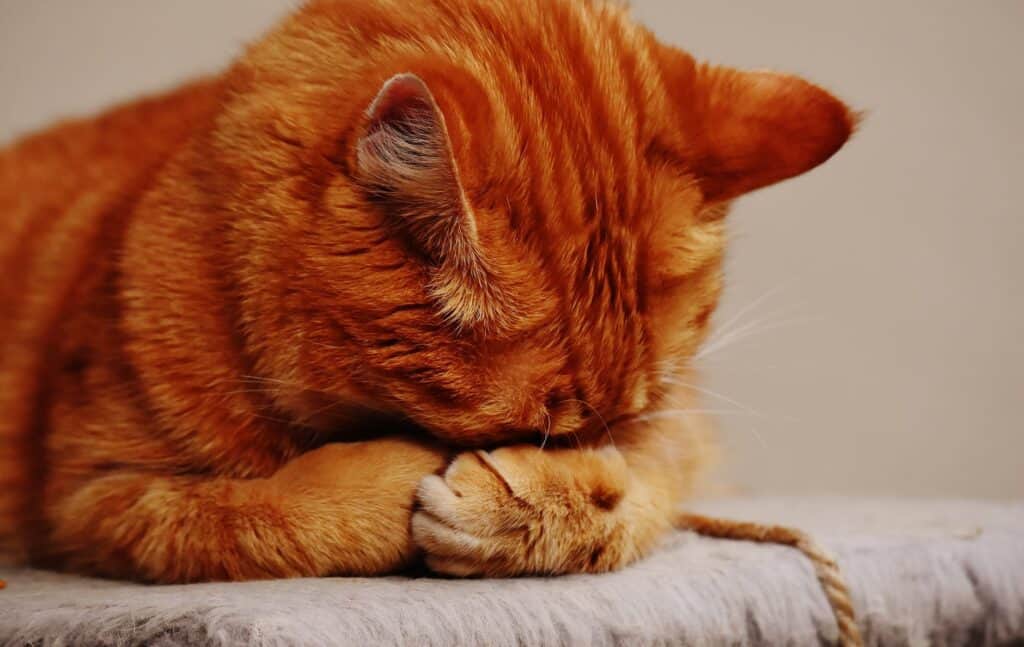
It is something that your cat may do unknowingly while vast asleep. It’s also something cats do when they don’t want to be disturbed or block out the light.
Maybe your kitty needs a sleep mask.
8. Monorail cat
The so-called monorail sleeping position is when cats fall asleep in a narrow space that is wide enough to accommodate their bodies. Usually on a narrow ledge, on the backrest of a sofa, or fence.
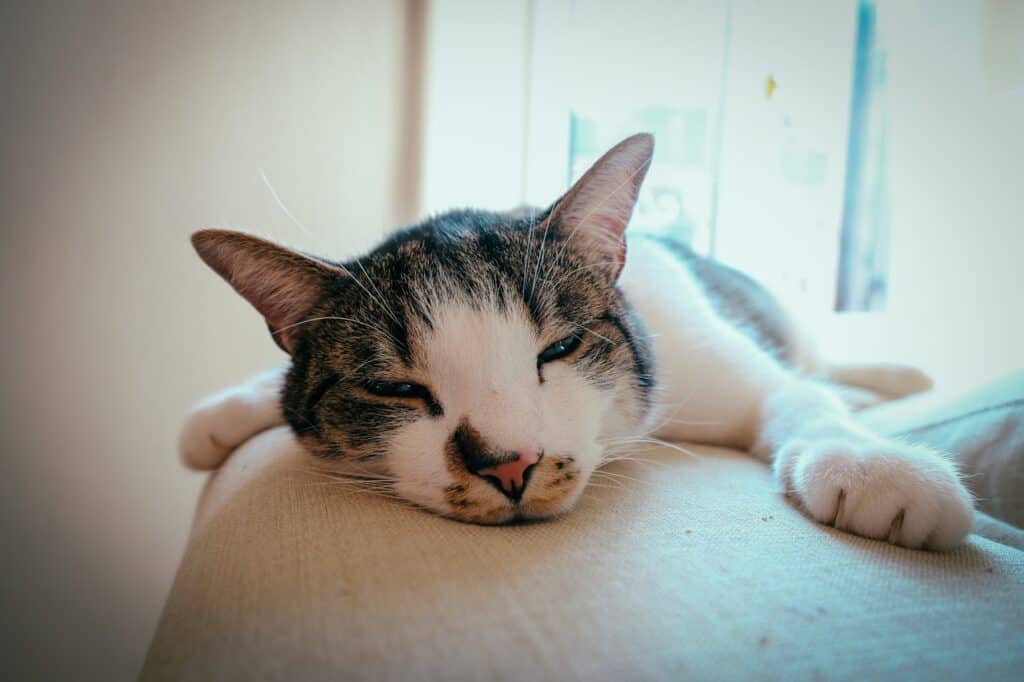
Sometimes they let their legs dangle on either side or let their headrest on their front paw. Cats love places like this because it’s excellent for surveillance. They’re usually hard-to-reach areas, putting them in a position where they can see others coming long before they reach them.
9. Contortionist
Have you ever seen your cat resting or sleeping in a position that resembles a ragdoll in a weird position?
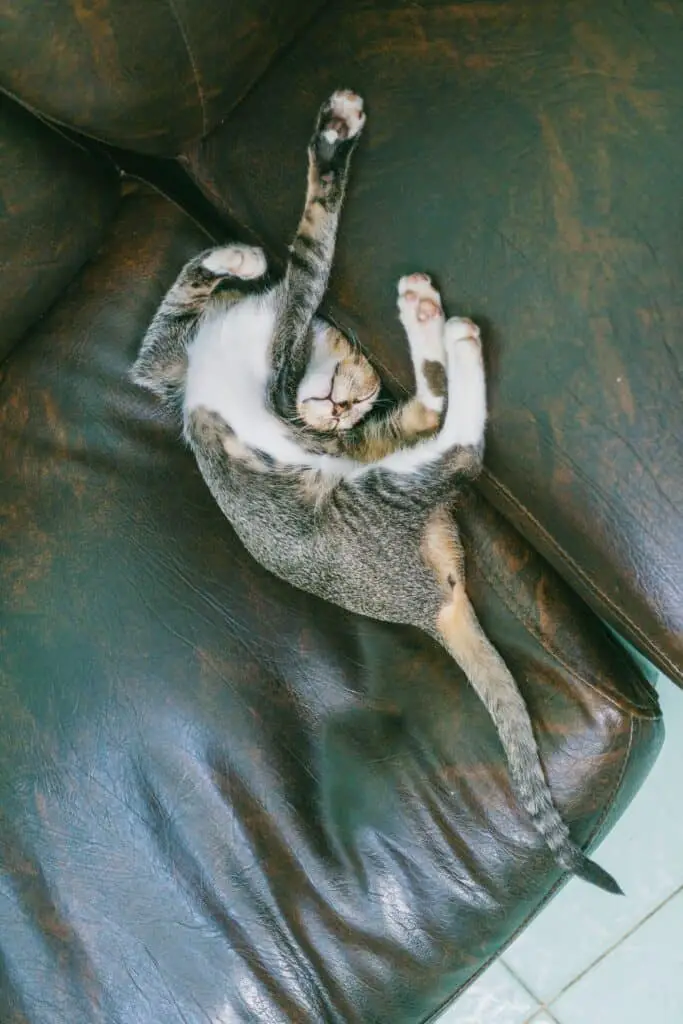
It’s sometimes hard for us to imagine that cats can be totally comfortable with their backs twisted around and their heads in an awkward position.
Cats have very flexible spines and can relax, even in the weirdest shapes. Often, you will see kittens or younger cats in these positions, and it’s also more common for males to do this.
Worrying or correcting your cat’s sleeping position when lying like this is no longer necessary. They’re perfectly fine, and it’s a sign that they’re comfortable, playful, and at ease.
Sit up sleeper
Cats who appear to be asleep while sitting straight up are a half-conscious, light sleep variant.
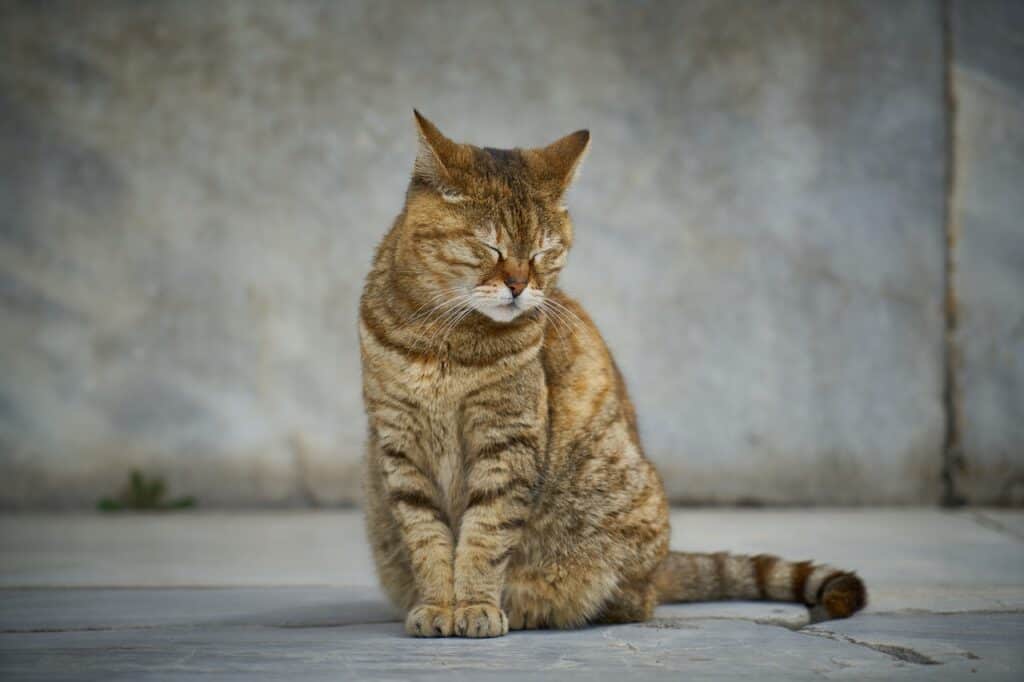
They like to doze off in this position while remaining alert to their surroundings and having a quick rest.
Like side sleeping cats or belly-up sleeping, when a cat is stretched out while sleeping, he doesn’t have any care in the world.
That’s a cat that feels 100% relaxed and safe in its home and together with you. While stretched out, they might often put their paw under their chin to prop up their head just a bit.
It’s gorgeous, and we can look at this for days.
12. Split level
This awkward sleeping position is when a cat sleeps on two different levels. Their bottom half could be on the floor while their head rests on something higher up, maybe a box or a big pillow.
It looks uncomfortable, and it’s like your cat just fell asleep in the middle of playing. We don’t see this often, but split-level sleepers are definitely out there.
13. Cat dormitory
We also refer to this type of communal sleeping as a ‘cat-party’. You can observe this treat when two or more cats sleep together and cuddle up with each other.
Cats will often use each other as a pillow and lay close together, but or like spoons keeping each other warm.
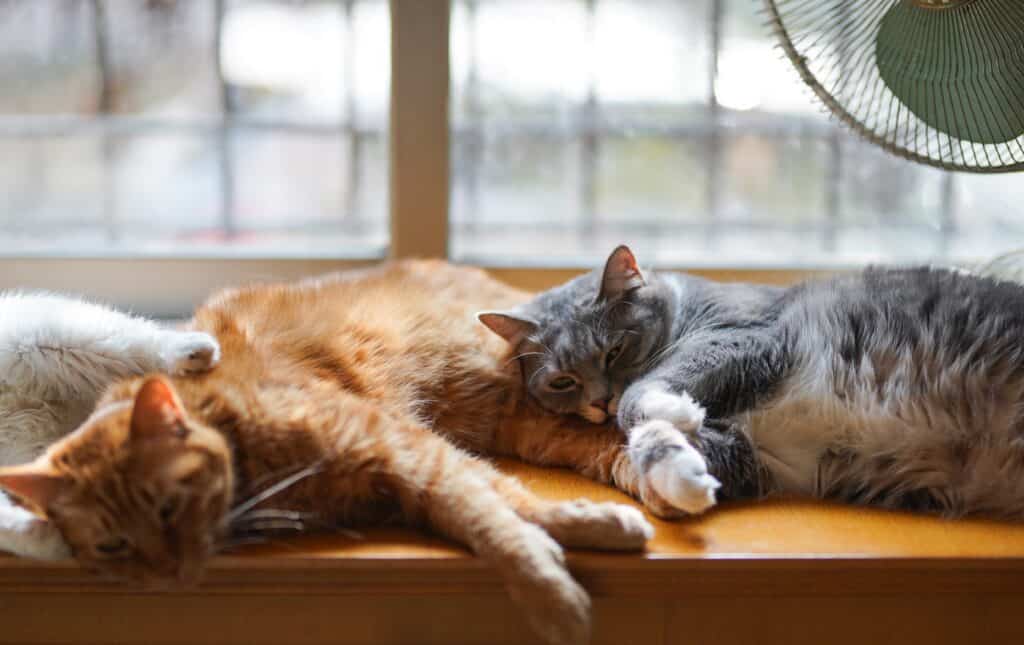
You will only see this happening with cats who are extremely comfortable with each other and most likely have been together since a young age.
Deep sleep versus alert sleep
Even with domesticated cats, their instincts inherited from life in the wild are still strong. Cats can deliver sudden bursts of energy, for example, when they chase prey, but they also fatigue quite fast.
As a result, cats need lots of sleep. Sometimes they can even sleep up to 20 hours per day. That’s not to say that all this time is spent in a deep sleep.
As mentioned earlier, cats often sort of doze off while staying alert and keeping an eye (or ear) on their surroundings.
When resting like that, cats can literally sleep with their eyes open and remain in a partially conscious state of mind.
This is a very light sleep and different from periods of deep sleep. On the other hand, cats can also engage in deep sleep, typically lasting relatively short. During this deep sleep, cats also dream a lot to help them process all the day’s impressions and emotions.
Why do cats sleep on top of you?
Cats wanting to sleep while laying on top of you is a very common thing. They do this for several reasons, mainly because they feel safe with you and want to spend time with you.
Like cats sleeping together with other cats, they trust; when your cat wants to sleep close to or on top of you, it’s because they love and trust you.
Sleeping positions that can hint at pain or discomfort
When a cat has trouble sleeping or is lying down in awkward positions, it might hint that they’re not feeling well and are likely in pain.
You know your cat best, and it could just be that their belly is full and they need to lie down for a while.
On the other hand, if you notice different sleeping behavior or your cat looks uncomfortable or anxious when lying down, usually, something is wrong.
Don’t rely on your cat to tell or show you when it’s in pain or something is wrong. Cats are masters at hiding pain because they know that showing pain or weakness is an excellent way to get hunted and killed in the wild.
Why do cats sleep all day long?
As with many things cats do, their sleep duration and sleeping pattern are inherited from when living in the wild. It’s baked into their instincts.
In the wild, cats sleep a lot to conserve energy. This ensures that a predator has enough energy to run and get themselves to safety or fight back when threatened.
Cats can run real fast and are capable of sudden boosts of activity. However, they don’t have much stamina and get fatigued quite quickly.
So, if you catch your cat sleeping most of the day, this is usually not a sign of trouble. If their sleeping pattern changes, observe your cat and
Why don’t cats want to sleep in their cat bed?
We experienced ourselves with our cats and often hear this from other cat owners.
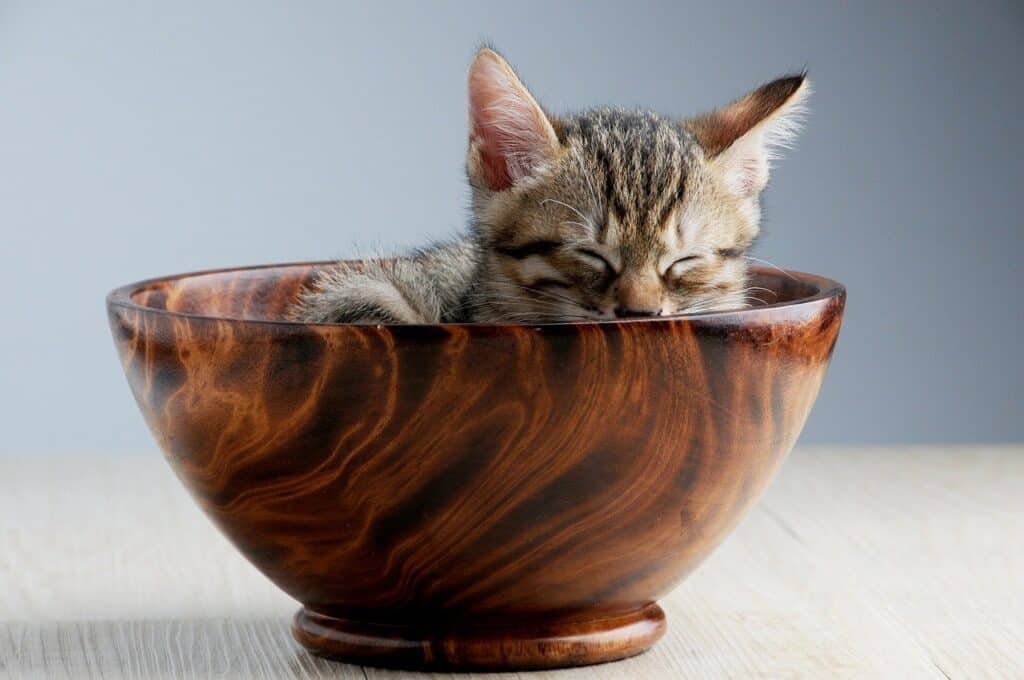
We go out of our way to find the nicest and most comfortable cat bed, only to find that our cats don’t want to go near it and prefer sleeping on a pile of laundry or in our beds (especially together with us, under the blankets)
Why?
As it turns out, the most likely reasons for this are:
It smells weird
Cats have a great sense of smell, about 14 times better than us humans, and they are very opposed to strong odors. That new cat bed might have a ‘factory smell’ or a smell they don’t know and don’t feel comfortable with.
It’s not in the right place
As cat owners, we know that our cats can be very particular about the places they sit in and even more about the places they feel comfortable sleeping in. The bed might just be in the wrong spot. Generally, cats don’t like to be out in the open when they sleep. They prefer a more covered area.
It’s too comfy
If it’s too soft and too comfortable, chances are that your cat will not like its bed. Yes, they want a comfy and warm place, but instead, lay down on a pile of rags or a cardboard box rather than on a soft pillow.

